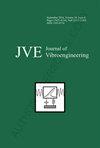基于新型混合深度学习的数控机床滚珠丝杠全方位误差补偿技术
IF 0.7
Q4 ENGINEERING, MECHANICAL
引用次数: 0
摘要
考虑到热现象对机床几何精度的不利影响,利用 LSTM 神经网络算法建立了机床滚珠丝杠全向误差模型。随后,结合华中数控系统的核心功能、QT 的可视化编程环境和 Matlab 的数值计算能力,设计出机床滚珠丝杠全向误差补偿模块。为了提高补偿模型的实用性和准确性,本研究采用了鲸鱼优化算法(WOA)来优化 LSTM 模型的参数。这提高了模型的泛化能力和预测性能,使其更加有效。在实验验证阶段,使用补偿方法对机床的 Z 轴误差进行了实际操作和分析。结果表明,在采用补偿方法后,Z 轴误差波动的峰值振幅已显著降低至 ±0.006 mm,与初始误差带宽 ±0.0145 mm 相比,降低幅度相当大。这些实证研究结果证明了所提出的补偿策略在大幅提高产品加工精度方面的有效性,从而为今后研究数控机床误差补偿技术提供了一个具有指导意义的重要基准。本文章由计算机程序翻译,如有差异,请以英文原文为准。
A ball screw all-round error compensation technology based on novel hybrid deep learning for CNC machine tool
Considering the detrimental impact of thermal phenomena on the geometric precision of machine tools, a machine tool ball screw’s omni-directional error model is created using the LSTM neural network algorithm. Subsequently, the machine tool ball screw's omni-directional error compensation module is devised by combining the core functions of the Huazhong numerical control system with the visual programming environment of QT and the numerical computation capability of Matlab. To enhance the practicality and accuracy of the compensation model, this study has employed the Whale Optimization Algorithm (WOA) to optimize the parameters of the LSTM model. This has resulted in an improvement in the model's generalization ability and prediction performance, making it more effective. During the experimental validation phase, the Z-axis error of the machine tool was practically operated and analyzed using the compensation method. Results manifestly show that, after employing the compensation method, the peak amplitude of the Z-axis error fluctuations have been notably curtailed to ±0.006 mm – a considerable reduction compared to the initial error bandwidth of ±0.0145 mm. These empirical findings substantiate the efficacy of the proposed compensation strategy in substantially boosting the machining precision of products, thus furnishing a substantial and instructive benchmark for future inquiries into CNC machine tool error compensation technologies.
求助全文
通过发布文献求助,成功后即可免费获取论文全文。
去求助
来源期刊

Journal of Vibroengineering
工程技术-工程:机械
CiteScore
1.70
自引率
0.00%
发文量
97
审稿时长
4.5 months
期刊介绍:
Journal of VIBROENGINEERING (JVE) ISSN 1392-8716 is a prestigious peer reviewed International Journal specializing in theoretical and practical aspects of Vibration Engineering. It is indexed in ESCI and other major databases. Published every 1.5 months (8 times yearly), the journal attracts attention from the International Engineering Community.
 求助内容:
求助内容: 应助结果提醒方式:
应助结果提醒方式:


